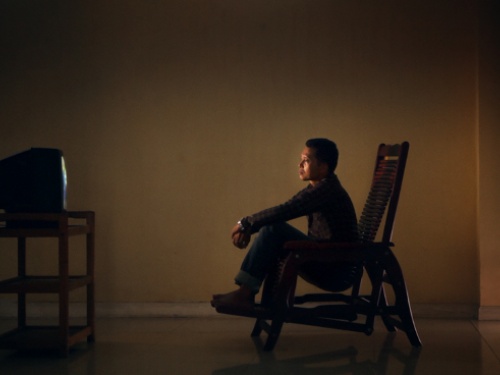The Art of Witnessing: Son of Saul
How should we represent the Holocaust? To coincide with the release of László Nemes’ impressive debut feature Son of Saul, a powerful depiction of the Holocaust, Maya Caspari explores the film and revisits the debates around the representation that it prompts.
Towards the end of László Nemes’ acclaimed debut feature film Son of Saul another prisoner tells Saul, played by Hungarian actor Géza Röhrig, that he is endangering their lives. “We’re already dead,” he replies.
It is not only that, as a member of the Sonderkommando—a group of prisoners forced to take new arrivals to the gas chambers and shovel away their ashes—Saul has at best only a few months to live before he too is killed. As Nemes’ film so powerfully illustrates, to be trapped in Auschwitz is to be in hell already.
Primo Levi wrote of the profound disorientation central to the experience of Auschwitz - the erosion or even inversion of the social values and categories through which life had previously been structured. To watch Nemes’ film is to be immersed in this world, yet also to feel alienated from it - to register its strangeness.
"To watch Nemes’ film is to be immersed in the world of Auschwitz, yet also to feel alienated from it - to register its strangeness"
From the opening sequence, we’re thrown into the middle of Auschwitz and mostly limited to Saul’s perspective, without any neat narrative introduction or explicit contextual information to direct us. There are few moments of dialogue or human contact in the film, and we encounter few individuals; the camera’s focus is primarily on Saul’s face, or the back of his head, around which a stream of often horrific images move, sometimes out of focus, as well as the mingled sounds of anonymous voices, screams, shots.
Violence takes place at the edges of the frame throughout; and this use of perspective is an expression of that violence in itself – in the world that Saul inhabits, it is so constant, so routine, that it has, almost, ceased to be noticeable. Rather than being highlighted by its horrific difference from the everyday, violence here is its very fabric.
In this way, Nemes also avoids sentimentalising, or aestheticizing, the violence he represents - a charge sometimes levelled at films such as Schindler’s List or The Pianist. Indeed, strikingly, unlike these earlier attempts to depict the Holocaust, Nemes’ film is almost devoid of music - so much so that when it does occur, it feels noticeably alien and almost jarring, such as in the office of the SS, or the grotesquely upbeat tunes in the opening sequence, which sees new arrivals being moved towards the gas chambers.
"This is no redemptive story of survival."
If to be a voyeur is to gain some form of pleasure from viewing the suffering of others—a pleasure, as Susan Sontag noted, that in part derives from the knowledge of the spectator’s own distance and safety from what is being framed—this is deflated by the film’s immersive techniques. There is no redemptive story of survival here. With its blurred peripheries and repeated close-up shots of Saul’s hollow stare, the film instead self-consciously asks us to look, with a certain complicity, through eyes of the witness – a witness we know is ‘already dead’.
In a comment on the nature of Holocaust memory, Primo Levi wrote, “we, the survivors, are not the true witnesses”. The implication is, of course, that some Holocaust testimony would remain forever unheard, with some atrocities known only by those who did not survive them. Based in part on the diary of members of the Sonderkommando that was discovered after the war, Nemes’ film alludes to this idea, retrospectively positioning Saul as a voice of the dead, even as it also draws attention to the limits of his individual perspective and absorbs us in his present. In this sense, the film does more than avoid the trap of voyeurism. Simultaneously within and beyond Saul’s present frame of vision, it evokes an act of witnessing that is at once symbolic and inevitably limited.
"The film evokes an act of witnessing that is at once symbolic and inevitably limited."
It has become a cliché to recall Theodor Adorno’s (often misquoted) dictum that to write poetry after Auschwitz must be barbaric, and yet this has set the tone for much of the subsequent debate: should something so traumatic that it is seen often as beyond language be represented - or does emphasising its status as an exception place it at a comfortable distance from the world that we would prefer to know? How can we empathetically represent the experiences of victims, while acknowledging the limits of that representation and the specificities of their stories?
What is engaging about Son of Saul is that it seems to avoid the polarised responses offered by these familiar questions. Both absorbed in Saul’s vision and retrospectively framing it, gesturing towards perspectives beyond those it is able to show, it asks us to reflect on the act of looking itself, thus negotiating a different path. ■
Son of Saul runs from 29 April 2016.
This article is posted in: Articles, Blog, Events, Film
Tagged with: Son of Saul, László Nemes, Holocaust, Auschwitz, Géza Röhrig, Theodor Adorno, Susan Sontag, Primo Levi, Holocaust Representation, Ethics of Representation, Film, Films, Maya Caspari








